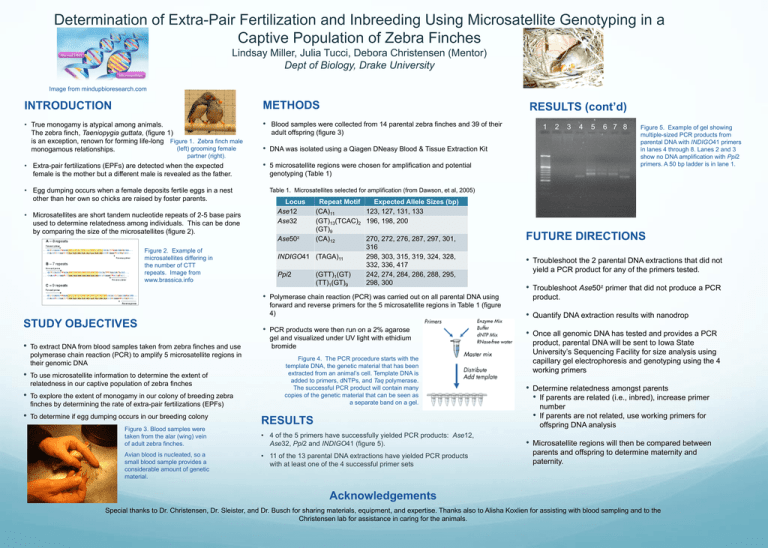Poster #36.pptx (2.022Mb)
advertisement

Determination of Extra-Pair Fertilization and Inbreeding Using Microsatellite Genotyping in a Captive Population of Zebra Finches Lindsay Miller, Julia Tucci, Debora Christensen (Mentor) Dept of Biology, Drake University Image from mindupbioresearch.com RESULTS (cont’d) INTRODUCTION METHODS • True monogamy is atypical among animals. The zebra finch, Taeniopygia guttata, (figure 1) is an exception, renown for forming life-long Figure 1. Zebra finch male (left) grooming female monogamous relationships. • Blood samples were collected from 14 parental zebra finches and 39 of their adult offspring (figure 3) • DNA was isolated using a Qiagen DNeasy Blood & Tissue Extraction Kit • 5 microsatellite regions were chosen for amplification and potential genotyping (Table 1) 1 partner (right). • Extra-pair fertilizations (EPFs) are detected when the expected female is the mother but a different male is revealed as the father. • Egg dumping occurs when a female deposits fertile eggs in a nest other than her own so chicks are raised by foster parents. Repeat Motif Expected Allele Sizes (bp) (CA)11 123, 127, 131, 133 (GT)13(TCAC)2 196, 198, 200 (GT)9 Ase50z (CA)12 270, 272, 276, 287, 297, 301, 316 INDIGO41 (TAGA)11 298, 303, 315, 319, 324, 328, 332, 336, 417 Ppi2 (GTT)1(GT) 242, 274, 284, 286, 288, 295, (TT)1(GT)9 298, 300 • • • • To extract DNA from blood samples taken from zebra finches and use polymerase chain reaction (PCR) to amplify 5 microsatellite regions in their genomic DNA To use microsatellite information to determine the extent of relatedness in our captive population of zebra finches To explore the extent of monogamy in our colony of breeding zebra finches by determining the rate of extra-pair fertilizations (EPFs) To determine if egg dumping occurs in our breeding colony Figure 3. Blood samples were taken from the alar (wing) vein of adult zebra finches. Avian blood is nucleated, so a small blood sample provides a considerable amount of genetic material. 4 5 6 7 8 Figure 5. Example of gel showing multiple-sized PCR products from parental DNA with INDIGO41 primers in lanes 4 through 8. Lanes 2 and 3 show no DNA amplification with Ppi2 primers. A 50 bp ladder is in lane 1. Locus Ase12 Ase32 Figure 2. Example of microsatellites differing in the number of CTT repeats. Image from www.brassica.info • 3 Table 1. Microsatellites selected for amplification (from Dawson, et al, 2005) • Microsatellites are short tandem nucleotide repeats of 2-5 base pairs used to determine relatedness among individuals. This can be done by comparing the size of the microsatellites (figure 2). STUDY OBJECTIVES 2 • Polymerase chain reaction (PCR) was carried out on all parental DNA using forward and reverse primers for the 5 microsatellite regions in Table 1 (figure 4) PCR products were then run on a 2% agarose gel and visualized under UV light with ethidium bromide Figure 4. The PCR procedure starts with the template DNA, the genetic material that has been extracted from an animal’s cell. Template DNA is added to primers, dNTPs, and Taq polymerase. The successful PCR product will contain many copies of the genetic material that can be seen as a separate band on a gel. FUTURE DIRECTIONS • Troubleshoot the 2 parental DNA extractions that did not yield a PCR product for any of the primers tested. • Troubleshoot Ase50z primer that did not produce a PCR product. • Quantify DNA extraction results with nanodrop • Once all genomic DNA has tested and provides a PCR product, parental DNA will be sent to Iowa State University’s Sequencing Facility for size analysis using capillary gel electrophoresis and genotyping using the 4 working primers • Determine relatedness amongst parents • If parents are related (i.e., inbred), increase primer number • If parents are not related, use working primers for offspring DNA analysis • Microsatellite regions will then be compared between parents and offspring to determine maternity and paternity. RESULTS • 4 of the 5 primers have successfully yielded PCR products: Ase12, Ase32, Ppi2 and INDIGO41 (figure 5). • 11 of the 13 parental DNA extractions have yielded PCR products with at least one of the 4 successful primer sets Acknowledgements Special thanks to Dr. Christensen, Dr. Sleister, and Dr. Busch for sharing materials, equipment, and expertise. Thanks also to Alisha Koxlien for assisting with blood sampling and to the Christensen lab for assistance in caring for the animals.






